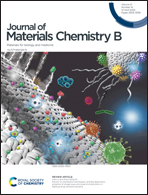Fluorescent nanodiamond immunosensors for clinical diagnostics of tuberculosis†
Abstract
Fluorescent nanodiamonds (FNDs) are carbon nanoparticles containing a dense ensemble of nitrogen-vacancy defects as color centers. These centers have exceptional photostability and unique quantum properties, making them useful for ultrasensitive biosensing applications. This work employed FNDs conjugated with antibodies as magneto-optical immunosensors for tuberculosis (TB) diagnostics using competitive spin-enhanced lateral flow immunoassay (SELFIA). ESAT6 (6-kDa early secretory antigenic target) of Mycobacterium tuberculosis is a clinical marker of TB. We evaluated the assay's performance using the recombinant ESAT6 antigen and its antibodies noncovalently coated on FNDs. A detection limit of ∼0.02 ng mL−1 was achieved with the lateral flow membrane strip pre-structured with a narrow channel of 1 mm width. Adopting a cut-off value of 24.0 ng mm−1 for 100-nm FNDs on the strips, the method detected 49 out of 50 clinical samples with Mycobacterium tuberculosis complexes. In contrast, none of the assays for 10 clinical samples with non-tuberculous mycobacteria (NTM) isolates exhibited the presence of ESAT6. These results suggest that the SELFIA platform is applicable for TB detection and can differentiate TB from NTM infections, which also affect the human respiratory system. The FND-enabled immunosensing techniques are versatile and promising for early detection of TB and other diseases, opening a new avenue for biomedical applications of carbon-based nanomaterials.

- This article is part of the themed collection: 2025 Journal of Materials Chemistry B Lunar New Year


 Please wait while we load your content...
Please wait while we load your content...